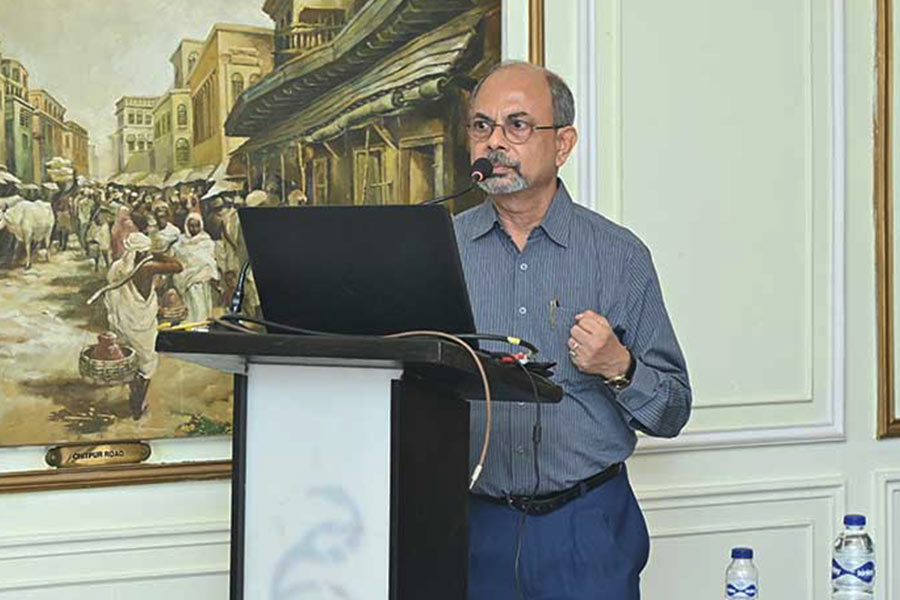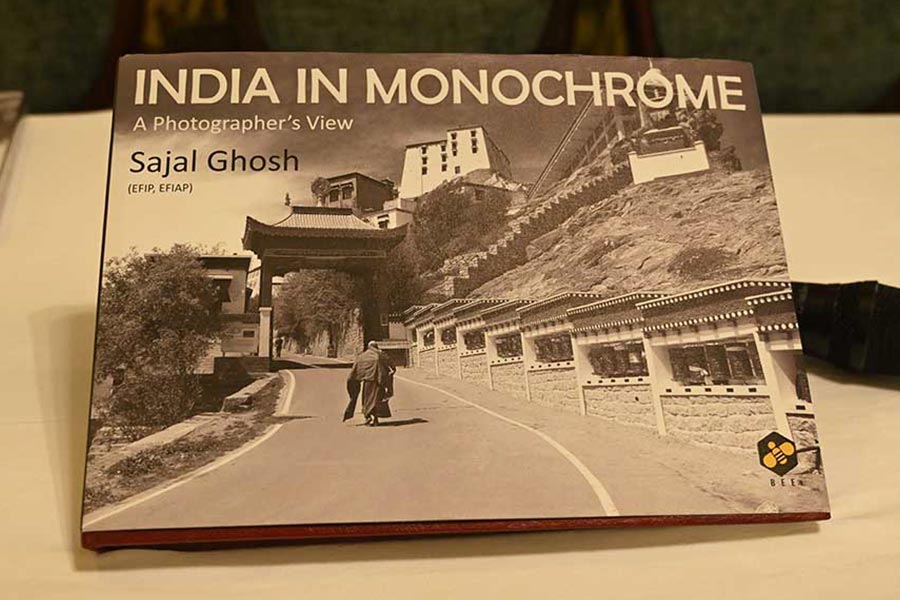A monk treks up a winding road, with a vast monastery set on the mountain face as the backdrop — this is the arresting image that greets you as you pick up India in Monochrome (BEE Books). Sajal Ghosh’s second published collection of photos offers a striking departure from his earlier work, India in Celebration (2021), which focuses on the vibrant festivities of the cultural landscape of India.
In this new collection, which was launched at The Bengal Club in May, Ghosh shifts his lens towards the quieter aspects of life, capturing the everyday moments that often escape notice. Presented in black and white, India in Monochrome is more than just a study in contrast. It is an exploration of the timelessness, texture and emotional depth that colour can sometimes obscure.
The images capture India in its everyday splendour and solemnity
Introductions by Jael Sililman, Jawhar Sircar and Arun Ganguly applaud the various subjects of the book. Divided into seven sections, from ‘Devotion’ to ‘Work’, the collection of photos varies from the silent interior of a Kolkata synagogue to the rocky barrenness of Ladakh. Spanning both time and geography, the images capture India in its everyday splendour and solemnity. Your eyes wander from the fearsome face of a cinder-smeared ascetic to the sweet smile of a bride from Bikaner. Synaesthetically, you can almost hear the bustle in a Kolkata market or the chimes of a busker on the stone pavements of Varanasi.
Monochrome photography holds a special power — by stripping away the distraction of colour, it forces the viewer to confront the essence of the subject through form, texture, light and shadow. The central philosophy of India in Monochrome seems to be a belief that life in greyscale can reveal deeper, more nuanced truths.
Ghosh’s career as a corporate lawyer stands in contrast to his passion for photography, but it also seems to inform it. The precision and attention to detail required in his day job are mirrored in his photographic compositions, which are meticulously framed and thoughtfully arranged.
‘When I first arrived in Bokaro in the 1980s, I didn’t know anything about photography’

Ghosh speaks at the Kolkata launch of the book at The Bengal Club in May Amit Pramanik
India in Monochrome includes photographs of India’s landmark religious places, of grand sights of nature and man, of people in their ordinary beauty, of art in motion, of life in the city, of simple acts of labour, and more. In one image, we see the shadows of mendicants cast against the ancient stone walls of a temple. In another, a Kumartuli artist sculpts earth into godhood. These landmark moments are presented with the same care that Ghosh gives to smaller, more intimate scenes of daily life. This sensitivity to the diversity and complexity of Indian life is something Ghosh emphasises when discussing his photographic journey over video call with My Kolkata. Reflecting on his early years, he recalls: “When I first arrived in Bokaro in the 1980s, I didn’t know anything about photography. Back then, there was no digital camera. Luckily, there was a camera club, which I joined and, gradually, I started picking up the necessary skills. I met somebody who became my guide. Eventually, I made more and more time for this passion.”
This mentorship, along with Ghosh’s innate curiosity, shaped his understanding of photography not just as a technical skill but as a means of connecting with the world around him. His early experiences with mechanical and analogue cameras helped him develop an appreciation for the art of seeing, a quality that is palpable in every photograph in India in Monochrome.
Ghosh’s images reflect an understanding of India’s cultural diversity, a theme that has been central to his work since his first book. “There are lots of differences between the various states — culturally, food habits, the way of talking, and language. India is a vast country. I haven’t been able to cover all the states, which may not be possible in a single lifetime!” says Ghosh. He speaks nostalgically of the local families he often stayed with (as part of shooting for the book) and their inherent kindness, especially his experience while covering the Hornbill Festival in Nagaland.
Ghosh’s India is one of contrasts

A still from ‘India in Monochrome’ BEE Books
The book’s structure reflects the fluidity of time and space in Ghosh’s work. “These pictures haven’t been captured in any particular time, there are pictures from a decade ago as well as two months ago,” says the photographer. This lack of a rigid timeline allows the viewer to engage with the photographs on their own terms, without the constraints of context.
In this way, India in Monochrome becomes an interactive experience, inviting viewers to find their own meanings in the images. “Photography is not my profession, it’s my passion,” says Ghosh, emphasising that his goal is not to dictate how his work should be understood, but rather to allow each viewer to bring their own experiences and emotions to the table. This approach is evident in the way Ghosh frames his subjects — he leaves space for the viewer to step into the scene, to imagine the colours, sounds and textures that might accompany the visual narrative.
For every viewer, India in Monochrome is a meditation on the power of photography to transcend time, culture and language. Ghosh’s India is one of contrasts — between tradition and modernity, the sacred and the mundane, chaos and stillness — and it is through these contrasts that the true beauty of the country emerges.



